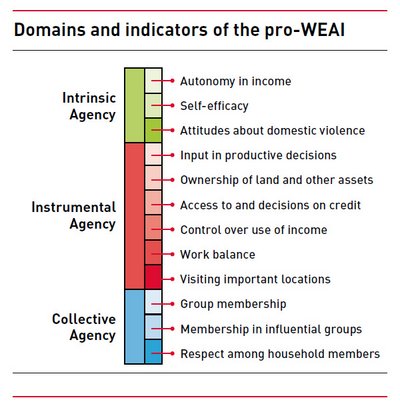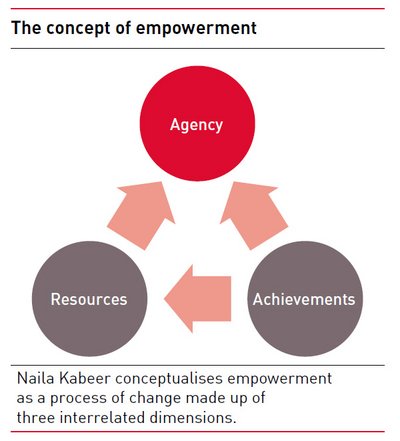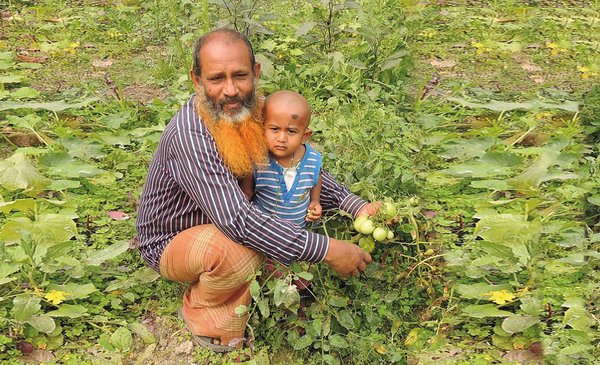 Download this article in magazine layout
Download this article in magazine layout
- Share this article
- Subscribe to our newsletter
Measuring women’s empowerment in agricultural development projects
Agricultural development agencies and project implementers increasingly recognise the importance of women’s empowerment in improving food and nutrition security. But if projects are using different approaches, how do we know which strategies worked best to empower women? Some projects could be teaching women how to prepare nutritious foods for their children, while others might be training milk traders on food safety practices. Whereas some projects could be organising women into self-help groups, others might be training men to be more supportive of their wives in caring for children. Without an appropriate metric that can be compared across settings, it would be very difficult to assess whether these projects are achieving their goals. It was this problem that led to the development of a new survey-based index for measuring empowerment, agency, and inclusion of women in the agriculture sector called the Project-Level Women’s Empowerment in Agriculture Index (pro-WEAI).
In April 2018, the pilot version of the pro-WEAI was launched by the Gender, Agriculture, and Assets Project, Phase 2 (GAAP2). Developed jointly by the International Food Policy Research Institute (IFPRI), the Oxford Poverty and Human Development Initiative, and 13 partner projects in the GAAP2 portfolio, the tool helps agricultural developmental projects assess women’s empowerment in a project setting, diagnose areas of women’s disempowerment, design strategies to address deficiencies, and monitor project outcomes. Pro-WEAI is an adaptation of the Women’s Empowerment in Agriculture Index (WEAI), originally developed in 2012 by IFPRI, the United States Agency for International Development (USAID) and the Oxford Poverty and Human Development Initiative (OPHI).
What does pro-WEAI actually measure?
 Pro-WEAI comprises twelve indicators of women’s empowerment in agriculture: autonomy in income, self-efficacy, attitudes about domestic violence, input in productive decisions, ownership of land and other assets, access to and decisions on credit, control over use of income, work balance, visiting important locations, group membership, membership in influential groups and respect among household members. These indicators are organised into three domains: intrinsic agency (power within), instrumental agency (power to) and collective agency (power with).
Pro-WEAI comprises twelve indicators of women’s empowerment in agriculture: autonomy in income, self-efficacy, attitudes about domestic violence, input in productive decisions, ownership of land and other assets, access to and decisions on credit, control over use of income, work balance, visiting important locations, group membership, membership in influential groups and respect among household members. These indicators are organised into three domains: intrinsic agency (power within), instrumental agency (power to) and collective agency (power with).
A respondent is considered adequate in a particular indicator if she or he reaches a certain threshold. For example, a respondent is adequate in group membership if she or he is an active member of at least one group in the community. The indicators are weighted equally, and a respondent is considered empowered if she or he is adequate in at least 75 per cent – or at least nine out of twelve – of the indicators.
The Three Domains of Empowerment score (3DE) is calculated from these twelve indicators, and reflects how many respondents are empowered across the three domains and the extent of their empowerment. Pro-WEAI is a composite index that tells us how empowered the women surveyed are as a group. Pro-WEAI combines the 3DE score with the Gender Parity Index (GPI), which assesses how empowered women are in comparison with the men in their households.
What is new about pro-WEAI?
The original WEAI is based on five domains of empowerment: production, resources, income, leadership and time. In pro-WEAI, we measure many of the same areas of empowerment, but organise them into domains that are more explicitly based on the existing literature on empowerment. For example, social economist Naila Kabeer describes empowerment as a dynamic process: resources enable women to have agency, or with the ability to make decisions, women can achieve outcomes (see Figure).
Pro-WEAI includes new indicators of empowerment that were not part of WEAI, assessing areas such as self-efficacy, domestic violence, mobility and intrahousehold relationships. Further, many of the indicators of pro-WEAI have stricter cutoffs for adequacy than WEAI to allow for projects to detect changes in empowerment over time. For example, in WEAI, a respondent is considered adequate in control over use of income if she or he has input in decisions about at least one source of income. In pro-WEAI, a respondent is considered adequate in this indicator if she or he has input in decisions about income from all of the income-generating activities in which she or he participates.
Pro-WEAI is intended to measure changes in women’s empowerment over the course of an agricultural development project, and it focuses on indicators of empowerment that a project could change. In addition, pro-WEAI includes optional add-on modules to look at women’s empowerment in projects that focus on outcomes related to nutrition, health and livestock.
What’s next?
Pro-WEAI was developed and tested using baseline data collected by nine partner projects in the GAAP2 portfolio. Partner projects are now designing their endline surveys in which pro-WEAI will be fielded again. Analysing pro-WEAI baseline and endline data in each of the participating projects will enable us to assess their impact on women’s empowerment. In the meantime, the GAAP2 index development team is using the projects’ pilot data, results and insights to continue to test and refine the new index.
Elena Martinez is a research analyst at the CGIAR Research Program on Agriculture for Nutrition and Health (A4NH), led by IFPRI.
Greg Seymour is an associate research fellow at the Environment and Production Technology Division at IFPRI. His research focuses on developing and testing the validity of various indicators of women’s empowerment, the gender dimensions of technology adoption, agricultural productivity, time use and subjective well-being.
Hazel Malapit is a senior research co-ordinator at the Poverty, Health and Nutrition Division at IFPRI,
and co-Principal Investigator for GAAP2.
Contact: h.malapit@cgiar.org
The original version of this article was published on the GAAP2 website.
References
- Kabeer, N. 1999. Resources, agency, achievement: Reflections on the measurement of women’s empowerment. Development and Change, 30(3), 435-464
https://onlinelibrary.wiley.com/doi/10.1111/1467-7660.00125
Previous GNIE blogs about pro-WEAI
- Hannan A. 2018. How can you tell if your survey questions work? Using cognitive testing to improve measurement of women’s empowerment in nutrition and health.
http://a4nh.cgiar.org/2018/04/16/how-can-you-tell-if-your-survey-questions-work/ - Martinez E. 2017. Progress in designing and implementing the project level WEAI.
http://a4nh.cgiar.org/2017/03/27/progress-in-designing-and-implementing-the-project-level-weai/ - Heckert J and Kim S. 2016. Developing a nutrition-sensitive pro-WEAI.
http://a4nh.cgiar.org/2013/04/12/tackling-malnutrition-means-quality-as-well-as-quantity/ - Balagamwala M. 2016. Development of a project-level WEAI begins at the GAAP2 inception workshop.
http://a4nh.cgiar.org/2016/02/17/development-of-a-project-level-weai-begins-at-the-gaap2-inception-workshop/
The Gender, Agriculture, and Assets Project, Phase 2 (GAAP2) is led by IFPRI in collaboration with OPHI and funded by the Bill & Melinda Gates Foundation, the United States Agency for International Development, and the CGIAR Research Program on Agriculture for Nutrition and Health. Visit the GAAP2 website to learn more about GAAP2 and WEAI Resource Center to learn more about pro-WEAI and other versions of WEAI.





Add a comment
Be the First to Comment